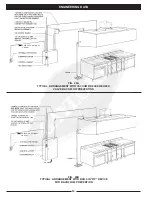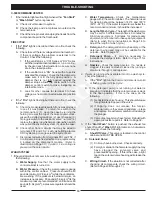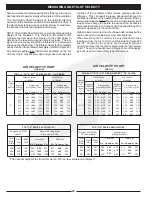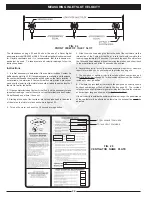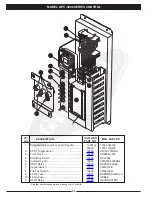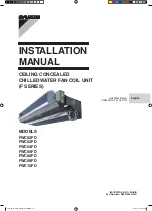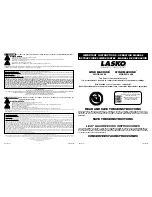
19
TROUBLE-SHOOTING
C-5000 COMMAND CENTER
1.
If the indicator lights will not light when either “Fan Start”
or “Wash Start” button is pressed.
A. Check circuit breaker to system.
B. Check the 4 amp and 2 amp fuses mounted on the
terminal block.
C. Check the nine pin socket and plug that leads from the
component board to the front board.
FIRE CYCLE
1.
If the “Fire” light is on solid but there is no fire, check the
following:
A. Check to see if there is voltage at terminal number 3.
If there is voltage, the problem is external to the
Control. Check the following:
1.
If the ventilator is a “CG” Series or “RG” Series
with thermostat activated damper, run a continu-
ity check on each thermostat to make sure none
are in the closed position.
2.
If the ventilator is a “RG” Series with a fuse link
activated fire damper, check the fire damper to
make sure it is in the fully open position. A
damper that is not fully opened against the
damper stops allows the micro switch in the
damper control switch to close, instigating an
internal fire mode.
3.
Look for other causes for terminal 3 to have
voltage such as misconnected wires at a junction
box.
2.
If the “Fire” light is flashing but there is no fire, check the
following:
A. Check the break glass fire switch, if one was provided,
to see if it was pulled. To return fire switch to the
normal position: (1) open the case by turning the
holding screw at the top of the case counter-clock-
wise with a slotted screwdriver; (2) open the case; (3)
flip toggle switch to the position marked “normal”; (4)
replace the glass rod which was broken when switch
was pulled to activate fire system; (5) close the case.
B. Check other Control circuits that may be wired to
terminals FS1 and FS2 - such as building alarms,
DDC systems, pre-engineered fire systems, etc.
C. Disconnect all wiring from terminals FS1 and FS2. If
Control remains in an external fire mode, replace relay
9 located on the component module. (Refer to
illustration on Page 30.)
Caution: Line voltage is
present on these terminals.
WASH SYSTEM
1. If the ventilator does not seem to be washing properly, check
the following:
A. Water Supply. See that the water supply to the
control cabinet is turned on.
B. Water Pressure - Check the water pressure gauge
within the control cabinet. Pressure should be 40
pounds minimum (2.8 kg/cm
2
) while the ventilators
are washing. If the pressure is below minimum, an
increase is necessary. 80 pounds (5.6 kg/cm
2
) is the
maximum pressure recommended; and if above 80
pounds (5.6 kg/cm
2
), a pressure regulator should be
used.
C. Water Temperature - Check the temperature
gauge within the control cabinet. The hot water used
for cleaning should be between 140°F and 180°F
(60°C - 82°C). If the water temperature is below the
recommended minimum, it should be increased.
D. Length of Wash Cycle - The length of the wash cycle
may be set for 3 different wash times, 3 minutes for
light-duty equipment, 5 minutes for medium-duty
equipment, and 9 minutes for heavy-duty equipment.
(Refer to wash timing instructions on Page 14 to
adjust the length of wash cycle.)
E. Detergent - The detergent tank may be empty, or the
detergent being used may not be suitable for the
purpose. Refer to page 12.
F. Detergent Pump - It may be necessary to
increase the detergent ratio. Refer to Page 11 for
instructions.
G. Nozzles - Check the spray nozzles. If a nozzle is
clogged, it is easily removed, cleaned by running a
small wire through it, and replaced.
2.
If water is running when ventilator is not in a wash cycle,
check the following:
A. If the “Fire” light on the Command Center is on solid
or flashing, refer to “Fire Cycle”.
B. If the detergent pump is not running, but water is
spraying, it indicates that the solenoid valve is stuck
in the open position. If this is the case, do the
following:
(1) Gently tap the valve housing. This should release
foreign material trapped in the valve.
(2) If tapping does not release the foreign
material, remove the valve coil and stem — clean
and replace. Be extremely careful not to damage
the plunger.
(3) Valve diaphragm may have failed. Rebuild with
appropriate size repair kit. Refer to Page 32.
3.
If the “Start Wash” button is pushed, the exhaust fan
shuts off and the “Wash On” light comes on, but water is
not spraying, check the following:
A. Shut-Off Valve - This valve is located in the control
cabinet and MUST BE OPEN.
B. Solenoid Valve:
(1) Coil may have burned out. Check continuity.
(2) Foreign material in the hot water supply line may
have clogged the solenoid valve and
prevented its opening. If this is the case, a light
tap on the solenoid valve housing will release the
valve.
C. Wiring Circuit - If the situation is not corrected after
checking all components, check the wiring circuit.
(Refer to Pages 34 through 41.)
Summary of Contents for CG Series
Page 34: ...32 DETERGENT PUMP ...
Page 35: ...33 MISCELLANEOUS VENTILATOR PARTS ...
Page 36: ...34 WIRING DIAGRAM FOR GPC 5000 WITH ELECTRIC FIRE DAMPER 120 VOLT ...
Page 37: ...35 WIRING DIAGRAM FOR GPC 5000 WITH FUSE LINK FIRE DAMPER 120 VOLT ...
Page 38: ...WIRING DIAGRAM FOR GPC 5000 S5 WITH ELECTRIC FIRE DAMPER 120 VOLT 36 ...
Page 39: ...WITH FUSE LINK FIRE DAMPER 120 VOLT WIRING DIAGRAM FOR GPC 5000 S5 37 ...
Page 40: ...WIRING DIAGRAM FOR GPC 5000 WITH ELECTRIC FIRE DAMPER 220 VOLT 38 ...
Page 41: ...WITH FUSE LINK FIRE DAMPER 220 VOLT WIRING DIAGRAM FOR GPC 5000 39 ...
Page 42: ...WIRING DIAGRAM FOR GPC 5000 S5 WITH ELECTRIC FIRE DAMPER 220 VOLT 40 ...
Page 43: ...WITH FUSE LINK FIRE DAMPER 220 VOLT WIRING DIAGRAM FOR GPC 5000 S5 41 ...
Page 46: ......












